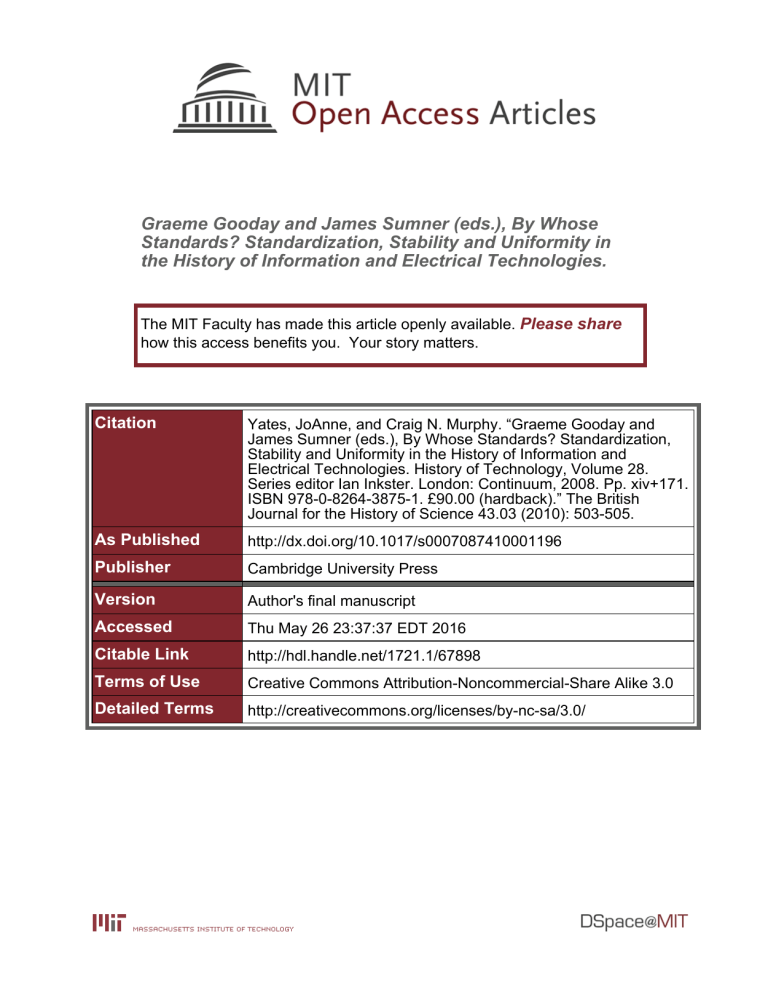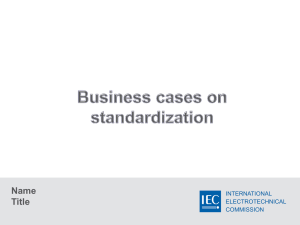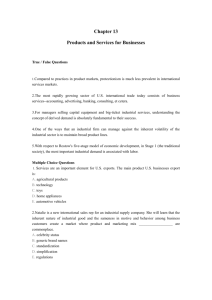Graeme Gooday and James Sumner (eds.), By Whose

Graeme Gooday and James Sumner (eds.), By Whose
Standards? Standardization, Stability and Uniformity in the History of Information and Electrical Technologies.
The MIT Faculty has made this article openly available.
Please share
how this access benefits you. Your story matters.
Citation
As Published
Publisher
Version
Accessed
Citable Link
Terms of Use
Detailed Terms
Yates, JoAnne, and Craig N. Murphy. “Graeme Gooday and
James Sumner (eds.), By Whose Standards? Standardization,
Stability and Uniformity in the History of Information and
Electrical Technologies. History of Technology, Volume 28.
Series editor Ian Inkster. London: Continuum, 2008. Pp. xiv+171.
ISBN 978-0-8264-3875-1. £90.00 (hardback).” The British
Journal for the History of Science 43.03 (2010): 503-505.
http://dx.doi.org/10.1017/s0007087410001196
Cambridge University Press
Author's final manuscript
Thu May 26 23:37:37 EDT 2016 http://hdl.handle.net/1721.1/67898
Creative Commons Attribution-Noncommercial-Share Alike 3.0
http://creativecommons.org/licenses/by-nc-sa/3.0/
Review of Graeme Gooday and James Sumner, eds., By whose standards? Standardization, stability and uniformity in the history of information and electrical technologies. History of
Technology, Volume 28. Series editor Ian Inkster. London: Continuum, 2008. Pp. xiv + 171.
ISBN 978-0-8264-3875-1. £90.00 (hardback).
By JoAnne Yates and Craig N. Murphy
This volume of the History of Technology series focuses on standardization, a subject of increasing interest across a range of disciplines. Editors Graeme Gooday and James Sumner have selected a diverse set of articles on standardization in the late 19 th
and 20 th
centuries, centering primarily on electrical and information technologies. The chapters dealing with information technologies demonstrate readily recognizable processes of standardization. Some of the chapters on earlier electrical technologies open out the realm of standardization much more broadly, often stretching our conceptions of the process.
The first essay in the book, addressing the most recent case, is Laura DeNardis’s study of
“IPv6: Standards controversies around the next-generation Internet.” In the early 1990s Internet overseers saw that existing IP addresses would run out without a new addressing system, so they initiated the search for one. DeNardis explores the contest that subsequently emerged between the approach developed by ISO (the International Organization for Standardization), and what became Internet Protocol version 6, a battle waged not over technical issues but over who would control the standard. The existing US-dominated standards body for the internet, the IETF
(Internet Engineering Task Force) was not willing to cede control to the ISO’s international body, which, in spite of its longer history, had come more recently to the Internet standards arena.
In “Standards and Compatibility: The Rise of the PC Computing Platform,”
James Sumner argues that the story around the PC platform is more complex and subtle than a battle between competing standards. “The PC was not (and is not) a single standard, but a broad constellation of specifications, varying in exactitude, across the levels of hardware, operating software, applications software and user culture. At all of these levels, possibilities exist ranging from conformity, through compatibility and interoperability, to outright rejection” (p. 102). The mechanism of standardization is also different here, with the de facto standard emerging within the market rather than via a committee system. Its sponsorship also shifted from IBM to
Microsoft over time. In this case, homogeneity and heterogeneity have coexisted side by side.
Frank Veraart’s “Basicode: Co-Producing a Microcomputer Esperanto” examines yet another approach to standardizing: developing a universal translator among the various dialects of Basic rather than specifying a single standard programming language. The need for this “Esperanto” emerged from the desire of hobbyists in the Netherlands using different hardware and programming languages to exchange software programs by broadcasting them over Dutch radio in the early 1980s. Veraart argues that Basicode was not a failure as it has typically been portrayed. Instead, “the technology underwent a distinctive full-circle trajectory from beginnings among enthusiasts, through co-option for mass-audience use by broadcasting professionals, to a final reformulation that firmly restated the original enthusiast ethic” (p. 131).
In his contribution, Andrew Russell addresses “Standardization across the Boundaries of the
Bell System, 1920-38 .
” As a monopoly, AT&T could readily standardize internally. The Bell system also, however, became involved in cross-boundary standardizing to shape things important to their system but not fully contained within it, working through various industrial standardizing committees including an ad hoc joint standards committee formed among industries with a stake in inductive interference (telephone, railroad, and power transmission); and a standardizing committee focused on washers, which could be used as slugs for pay telephones. Generalizing beyond these specific cases, Russell highlights the work of standardizing committees as part of “the cooperative social network that sustained the American style of competitive managerial capitalism” (p. 49).
The other two articles on electrical standards move into the realm of what the editors refer to as
‘soft’ standards. Chris Otter examines “Perception, Standardization and Closure: The Case of
Artificial Illumination.” This article considers not the competition among different specifications or standards for the same product, but that among different technical approaches to gain the same end—illumination. In particular, he focuses on user visual perceptions of what type of light (e.g., the blue light of electricity or the yellow light of gas lighting) is desirable for different uses, arguing that the eventual triumph of electrical light for most uses in the developed world was by no means a forgone conclusion, nor is it universal even now.
In “
Morality, Locality and ‘Standardization’ in the World of British Consulting Electrical
Engineers, 1880-1914,” Stathis Arapostathis examines the role and identity of consulting electrical engineers in building municipal electrical systems. Here, the profession of consulting electrical engineers was standardized, rather than the components and processes of electrification itself. Manufacturers would have preferred the latter, but that would have limited the scope of consulting electrical engineers, who sought to protect their role and status. Moreover, from municipalities’ point of view, consulting engineers with broad professional discretion could take local financial, moral, and national issues into account.
The final paper of the volume is an outlier in many respects. Karen Sayer ’s “Battery Birds,
‘Stimulighting’ and ‘Twilighting’: The Ecology of Standardized Poultry Technology,” focuses on chickens and eggs in mid-20 th
century Britain, with electrical lighting coming in only tangentially, as a mechanism for standardizing egg production. Here eggs were the target of standardization. While egg marketing rhetoric and images increasingly emphasized “natural” farming methods, the demand for fresh eggs of standard sizes all year round led to standardizing the way laying chickens were farmed. Although it detracts from the unity of the collection around information technology and electrical technology, this piece provides a fascinating glimpse at what happens when living organisms are standardized.
While this book does not deal with metrological standardization, more central to history of science, it adds value by challenging how we understand standardization in the realm of technology and industry. It should be read by all those interested in processes of standardization.





